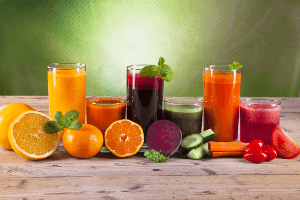Juicing is a popular practice in today's health-conscious society, because for many, it’s a preferable way to get nutrients.
The American Health Association advises that five servings of fruits and vegetables per day is required for optimal health. For many, the idea of eating Brussels sprouts or planning their meals around cooking fresh vegetables is inconvenient and not very appetizing. Most of us would rather grab a handful of crackers or make a pasta or mac and cheese for dinner.
With juicing however, you can get five servings of your fruits and vegetables in one glass.
But health experts disagree on how healthy juicing actually is. Some say that when you buy fresh juice there is additional added sugar that isn’t so great for your body. Or if you use a juicer at home, the skins of the fruits and vegetables (where the vast majority of the nutrients lie), are separated out, so you miss the true health benefits when you juice.
Other argue that you should eat whole fruits and vegetables rather than juice, so you can control the level of sugar you put in your body. Juicing concentrates the sugars of multiple fruits which you normally wouldn't eat in one sitting, which make your blood sugar levels spike.
However, juicing is preferable to not eating fruits and vegetables at all, or not eating enough. Another alternative for those who don’t want to cook or prepare their vegetables is a smoothie.
Green smoothies are very popular, and although they can be gritty and feel more like a shake than a drink, this is a way to get your added nutrients that juicing misses. When you make a smoothie, the skin is processed along with the rest of the fruits and vegetables, providing fiber, Vitamins, and minerals like potassium and magnesium (found in bananas and spinach).
The key to making a healthy juice or smoothie is to consider the ingredients you use as well. If you add three bananas and a pint of strawberries to a handful of spinach, that contains a lot of sugar you wouldn’t normally eat if you just ate the fruit whole. So be mindful of portions. Mix your greens so you can get a more mild taste, like pairing celery with spinach or kale with romaine lettuce, which has a milder taste. Consider adding flax seed oil for a healthy fat, or peanut butter, yogurt or almond milk for protein.
Using seasonal fruits and vegetables is a good way to mix things up so you don’t get bored with the same old smoothies. For instance, incorporating pumpkin into your smoothie for the fall along with almond milk and cinnamon makes for a healthy, delicious alternative to pumpkin spiced coffee.
There are a lot of options to try and get your five servings a day, so have fun!
